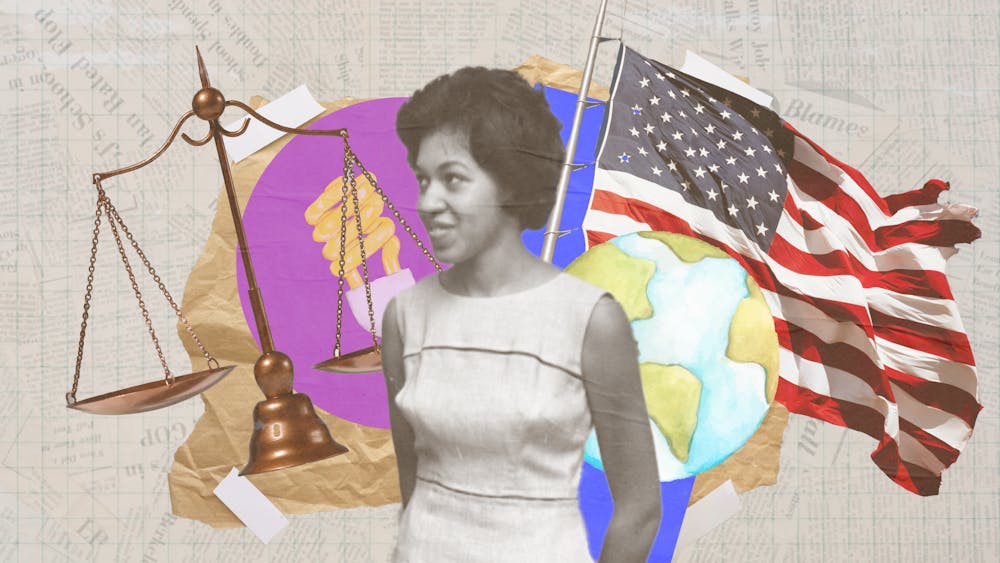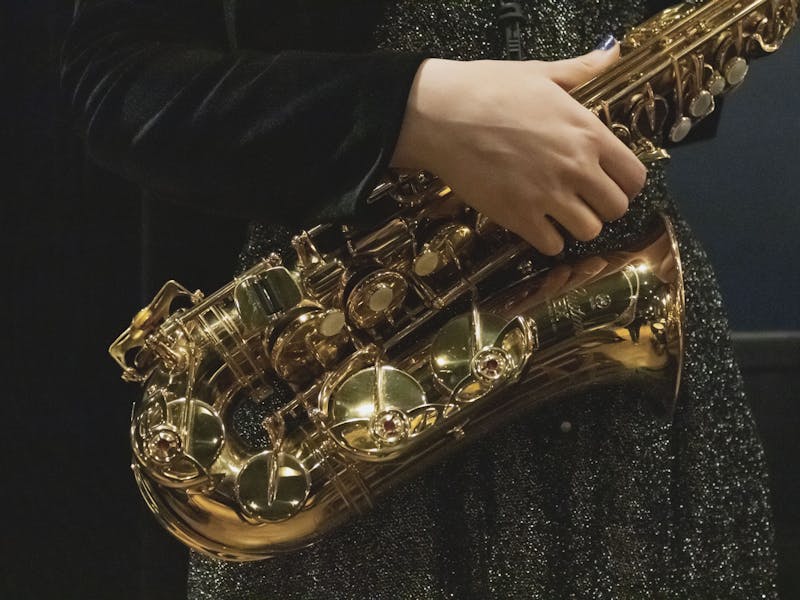As the mid-morning sun lit up the Horseshoe, a crowd gathered outside of McKissick Museum on Sept. 11, 2023, and hushed their applause to hang onto the words of a civil rights pioneer: Dr. Henrie Monteith Treadwell.
On that same date in 1963, Treadwell, along with Robert Anderson and James Solomon Jr., made history as the first Black students to enroll at USC since the end of Reconstruction in 1877. Treadwell, encouraged by her politically active family, had sued the university for admission following an initial rejection. The Presidential Commission on University History details how with the help of successful civil rights lawyer Matthew Perry and organizations such as the National Association for the Advancement of Colored People, Treadwell was successful in her case, opening a door that many others would pass through in the 60 years to come.
Treadwell, accompanied on stage by members of the Solomon and Anderson families, rose to speak on the same campus that she had fought to be included in, recognizing a future monument that will depict all three trail-blazing students. A monument she believes will serve to commemorate both history and the spirit of progress.
“It is my distinct honor to be here to celebrate a major accomplishment in the state of South Carolina,” Treadwell said. “I think that when we disturb the earth by establishing the monument it is inimical to disturbing the system that occurred 60 years ago. A system that will never be the same."
Throughout her speech, Treadwell expressed both pride at the change that has occurred since her time at the university and a sense of urgency for the progress yet to be made.
“We were not afraid... we were leading to a future that we hoped for, for all in our state and nation,” Treadwell said. “I take great pride, as I’m sure Bob [Anderson] and Jim Solomon do, in the changes that have been brought. And much is yet to come, we have only just begun. More is needed, more will happen."
As for the role of the monument, designed by renowned sculptor Basil Watson, Treadwell stresses the importance of the message it will send to everyone who sees it.
“The monument is a catalyst. I would say to those who do not believe that the significant efforts made by the trustees, the administration and everyone who supported the effort — and there were many — we cannot lose track of the fact that we entered this institution on a very peaceful day, which meant that many decided 'Let the time come,'” Treadwell said. “For those who were not ready then and are not ready now, I have one message: those days of old, those days are gone and will never come again.”
University President Michael Amiridis and Student Body President Emmie Thompson attended and spoke at the event, and many other university staff could be found in the audience. Students were also a prominent part of the crowd at the monument ceremony. One such student, Brianna Smalls, emphasized the impact that seeing Treadwell speak had on her.
“I think hearing Dr. Treadwell was so inspiring because when you hear about the three people who desegregated the university you just hear them as names, but when you actually see them and hear them talk about their legacy it’s just so inspiring to want to move on, to help,” Smalls said.
Attending the ceremony not only allowed Smalls to absorb the speech and presence of Treadwell but also prompted her to contemplate the significance of an enduring monument to the activist's historic actions. Smalls, a senior who is both Black and studying political science, specifically highlighted the importance of the monument and others like it in the aftermath of the recent affirmative action decision.
On June 29, 2023, the Supreme Court ruled against the constitutionality of affirmative action programs at Harvard University and the University of North Carolina, effectively overturning the 2003 case Grutter v. Bollinger, which stated race could be considered in college admissions. Critics of the ruling have said that the decision has removed programs critical to removing racial barriers in higher education (NBC News).
“I think they are important because — especially at a time with the affirmative action case being released — just seeing the monument to the desegregation of the university, it’s important to remember why we have steps like affirmative action in the first place,” Smalls said.
Smalls also reflected on how the ceremony underscored the significance of educating people on Black history in a time when it has come under increased scrutiny. According to ABC News, bills to limit the teaching of racial history in the United States have cropped up in over 25 states, mainly following the lead of the Florida Board of Education, which passed a bill banning critical race theory from public schools in 2021. This pressure to sanitize American history is being felt in classrooms across the nation, with many teachers feeling like they may face consequences for teaching Black history the Washington Post explained.
“I think there are very important conversations to have, and we shouldn’t stray away from these tough conversations,” Smalls said. “I know a lot of [people] were like, ‘It’s going to make children feel bad about themselves.’ I think it’s important to be able to talk about these conversations because this is history, we have people who have lived through this, and having them able to share their stories is so important."
Regarding the progress the university still must make, Smalls believes the key to addressing Black students’ needs is in following through on its promises and genuinely listening to student interests. She specifically mentioned resistance to the renaming of certain buildings such as the J. Marion Sims Residence Hall.
J. Marion Sims, known as the "father of modern gynecology" for his invention of the speculum and development of a method to repair vesicovaginal fistula, performed unethical experiments on enslaved Black women without anesthesia. As USA Today discussed, these experiments were not only inhumane and incredibly painful but were performed under racist assumptions about Black anatomical differences that continue to impact healthcare today.
In June 2020, student leaders submitted the 2020 Revision, a document that outlined specific actions for the university to create a more socially just institution, to university leadership. Included in this document was a demand for the university to change the names of several buildings due to their ties to racist historical figures — specifically, the J. Marion Sims Women’s Residence Hall, Strom Thurmond Wellness & Fitness Center and the Thomas Cooper Library. The university faces opposition in renaming the buildings from the state government. Governor Henry McMaster has publicly disagreed with any changes and the Heritage Act makes the switch legally difficult, according to the State. The Heritage Act has since been amended by the state Supreme Court to require a simple majority in the State Congress, rather than a two-thirds majority. to change historic names of monuments and buildings. In her panel with acclaimed journalist Beryl Dakers, Treadwell discussed her frustration with the university’s lack of follow-through on renaming the Sims residence hall. Many students, as well as alumni and others, continue to express similar feelings regarding the university’s inaction.
In the face of those challenges and others, seeing Treadwell speak reaffirmed Smalls' commitment to further equity at the university and reinforced her admiration of the civil rights leader.
“It was very inspiring to listen to everyone speak and just talk about how monumental this is and how important it is to remember the past but also move forward and also actively take steps to move forward,” Smalls said.
Tremayne Ansani, vice president and incumbent president of the Black Honors Caucus, found himself experiencing a similar combination of amazement and reflection after attending a lunch with Treadwell.
“I was awestruck, to be honest. It’s just so amazing but also saddening for me just because this is 60 years ago, this wasn’t really that long [after] segregation and everything," Ansani said. "These people went through so much to cause this huge positive impact for me to be here, for all minorities to be here.”
The experience also inspired Ansani to continue advocating for Black students and create further change on campus.
“It makes me think there’s so much more improvement and things that can be done in order to create a more positive and inclusive environment,” Ansani said. “My contributions can hopefully contribute to at least one person and further generations."
Ansani’s lunch with Treadwell included several other Black students in leadership roles, and the group discussed the changes that they wanted to see as well as their personal experiences on campus. Ansani has particularly noticed the lack of inclusion in campus events and the isolation of often being the only Black person in a class, organization or peer group.
“Specifically for Black USC, we sometimes feel that USC does a great job of giving us our space, but they don’t really allow us to go into other spaces. A big topic we were talking about was Homecoming and how a lot of people in the Black community don’t go to a lot of the events except the step show,” Ansani said. “Hopefully in the future, when we ask the next generation, they have a different experience of seeing a better focus on not only the diversity but also the inclusion of Black people and other minorities.”
In recent years, USC has faced backlash on several racial justice issues, including the reduction of funding and staff for the Office of Student Multicultural Affairs and the choice to maintain offensive building names, according to The State.
“Especially during 2020 and the [Black Lives Matter] movement, the school says a lot of stuff, but they don’t have any action, or they say it to calm down [the public],” Ansani said. “We talked about how sometimes you just have to be a squeaky wheel and you have to keep on making noise.”
And after listening to Treadwell’s panel, "I Do Not Wish to be a Symbol", freshman Nauri’a Crawford felt inspired to do just that and was encouraged to use her voice despite her youth.
“It did [inspire]. Being a freshman I feel like it shows you can go far. Don’t just stop where you’re at, don’t be content, continue to keep going no matter how old you are,” Crawford said.
From her entry into USC to her impactful research in public health and community-based health care, Treadwell has committed her life to improving human lives, and her visit to campus has inspired students to reshape the university community. Treadwell does not wish to be a symbol, but her dedication has made her a role model in the eyes of USC students.
"We three were the little engine that could and did," Treadwell said. "And I think that is what we are looking for today. Many more... 'little engines' that will apply their skills, their knowledge to the significant types of educational and social change that we have seen in this institution."



